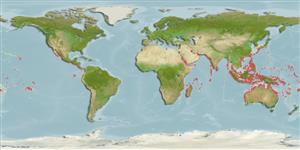Common names from other countries
Environment: milieu / climate zone / depth range / distribution range
Écologie
; saumâtre; profondeur 0 - 10 m (Ref. 96667). Tropical
Distribution
Pays | Zones FAO | Écosystèmes | Occurrences | Introductions
Indo-Pacific.
Length at first maturity / Taille / Poids / Âge
Maturity: Lm ? range ? - ? cm Max length : 8.0 cm CW mâle / non sexé; (Ref. )
Description synthétique
Morphologie
Surface of carapace smooth, ridges low but distinct; front with 6 equal-sized, rounded lobes. Color: dark to olive green overall.
Also caught by nets (Ref. 343). This species possess toxins but in low toxicities, and are therefore considered as a toxin-free crab (Ref. 130560). Found along the neritic zone (Ref. 97241). Inhabits shallow non-reef habitat with soft substrates (Ref. 106854), and intertidal mudflats (Ref. 128960). Estuarine (Ref. 106854). Prefers areas near mangroves, on mangrove swamps per se (Ref. 8752) or with muddy-rocky substrates (Ref. 343) in intertidal platforms (Ref. 8752). Also found in reef areas. A free-living predatory carnivore (Refs. 97241, 128960). Feeds mainly on slow-moving invertebrates colonizing mangrove swamps; also a scavenger (Ref. 8752).
Life cycle and mating behavior
Maturité | Reproduction | Frai | Œufs | Fécondité | Larves
Members of the order Decapoda are mostly gonochoric. Mating behavior: Precopulatory courtship ritual is common (through olfactory and tactile cues); usually indirect sperm transfer.
Ng, P.K.L. 1998. (Ref. 343)
Statut dans la liste rouge de l'IUCN (Ref. 130435)
statut CITES (Ref. 108899)
Not Evaluated
Not Evaluated
Menace pour l'homme
Utilisations par l'homme
Pêcheries: commercial
| FishSource | Sea Around Us
Outils
Sources Internet
Estimates based on models
Preferred temperature
(Ref.
115969): 24.3 - 29.3, mean 28.3 (based on 3830 cells).
Résilience
Haut, temps minimum de doublement de population inférieur à 15 mois (K=1.7).
Vulnérabilité
Low vulnerability (10 of 100).
Catégorie de prix
Unknown.
